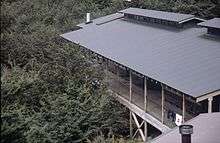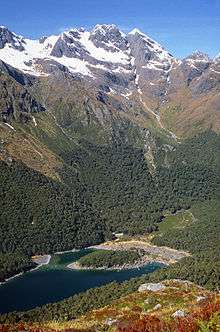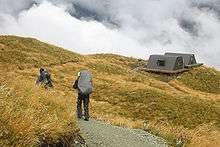Routeburn Track
The Routeburn Track is a 32 km long tramping (hiking) trail in the Fiordland and Mt Aspiring national parks on the South Island of New Zealand.
- This article is an itinerary.
Understand
| Month | Oct | Nov | Dec | Jan | Feb | Mar | Apr |
|---|---|---|---|---|---|---|---|
| Temperature max. °C | 22 | 24 | 25 | 28 | 29 | 28 | 23 |
| Average Temperature °C | 14 | 15 | 17 | 18 | 20 | 19 | 14 |
| Temperature min. °C | -1.5 | -2.5 | -1 | 0 | -1 | -2.5 | -4 |
| Rainy Days | 15 | 17 | 18 | 13 | 9 | 12 | 14 |
The Routeburn track's origins are in historical Maori walking tracks used to walk between locales.
Entry to the track is at approximately 200m altitude, and the highest point is approximately 1255m at the Harris Saddle.
The track may be walked in either direction: either from The Divide to Routeburn Shelter, or vice-versa. The ends of the track are some 350km by road from each other due to the very large mountain range the track traverses.
The track features ranger-occupied accommodation during peak summer months (October - April). These must be booked in advance through the Department of Conservation - the track is run as a Great Walk, and huts cost $65 per night. Although you don't need to book as early as the Milford Track, it is worth booking as soon as your travel dates are known (looking in October there was limited availability for the upcoming summer).
Prepare

Just like any multi-night tramping excursion, be sure to lay out your plans in advance. Make a packing list and check it before leaving. Preparedness is key to surviving an emergency in the wilderness.
- Clothing.
- Wet-weather clothing. Expect rain in this area. Milford Sound sees a tremendous amount of rainfall year-round.
- Warm-weather clothing.
- Extra clothing. Expect the clothing you tramp in to get wet and as such, you will need extra clothing to change into when not on the track.
- Eating.
- Cooking equipment. You must pack in your own cooking gear such as pots, as none are provided. During the peak-season gas cookers are available in the huts, but during the off-season they are removed so you'll need to pack your own cooker and fuel. Bring a lighter or matches for lighting the gas rings.
- Food. You must pack in your own food as there is no opportunity to purchase food. Be sure to prepare a menu consisting of high energy, low weight foods to carry in with you. Always carry at least one extra day's worth of food in case of emergency. Emergency rations can be an easy and compact way to bring in extra calories.
- Utensils. Your best bet is to carry a single utensil, such as a spork, that will aid in cooking as well as eating.
- Hygiene.
- Calls of nature. Be prepared to bury any waste, but also be aware that toilets are fairly regular along the track and it is preferred that you use them. If you do feel the call of nature and cannot wait for the next toilet, be sure to move a good distance off the track and away from any water sources and bury the waste.
- Showering. There are no showers available, but given the climate on the track and the abundance of moving water, you can expect to get wet. It's suggested to carry a small towel, preferably a lightweight, highly absorbent one.
- Insect repellent. You may be bothered by sandflies which are small biting insects similar to mosquitoes or biting midges.
- Sleep gear. There are mattresses provided in the bunkrooms of the huts year-round, but there are no linens. You will need to carry something to sleep in or on that will keep you warm as there is no heating offered in the bunkrooms. Earplugs are also suggested if you are a light sleeper as the bunkrooms are shared with a large number of other trampers.
- Water. The water that is available at the huts is collected in the area surrounding the hut, either from a nearby river or from rainfall.
- Bottle. Carry a bottle or other water carrier such as a CamelPak that can be accessed easily. Drinking regularly to maintain hydration is extremely important during such continuous activity.
- Treatment. Carry your preferred method of treating water.
- Something to do in the evening. As you may arrive at a hut in mid-afternoon, and weather or sandflies may keep you indoors, you might want to bring a book to read, or a game to play.
Transport

Walkers can depart from Queenstown to enter the track from the Routeburn Shelter, or depart from Te Anau to enter the track from The Divide. During the Great Walks peak season, daily transport onto either end is provided by Info&Track, tel:+64 3 442 9708.
Car relocation is also a popular transport option, saving walkers a lot of time - it takes 5 hours to drive between one end and the other. Easyhike.co.nz provide car relocation from either end of the track to the other. tel: +64 27 3707019
Walk
🌍
Routeburn Shelter - 🌍
Routeburn Flats Hut
Distance: 6.5 km, Altitude: 200 m, Duration: 2 - 3 hours
Detour to 🌍
North Branch Rouetburn
Duration: 4 - 5 hours return
Routeburn Flats Hut - 🌍
Routeburn Falls Hut
Distance: 2.3 km, Altitude: 400 m, Duration: 1 hour
Routeburn Falls Hut - 🌍
Mackenzie Hut

Distance: 11.3 km, Altitude: 200 m, Duration: 4 - 6 hours
Detour to 🌍
Conical Hill
Duration: 1 - 2 hours return
The 360o view is spectacular on a fine day.
Most people leave their packs inside the Emergency Shelter at Harris Saddle.
Mackenzie Hut - 🌍
Howden Hut
Distance: 8.3 km, Altitude: 150 m, Duration: 3 - 4 hours
Beware the Keas
Kea next to the Kepler Track above Luxmore Hut overlooking South Fiord Lake Te Anau - Beware, they can seriously damage you pack, boots or cloths. The Kea are a high altitude bird that forages in groups in alpine areas. They have powerful beaks for dislodging their food in the hard ground. They are highly intelligent, work co-operatively in groups, are very inquisitive and potentially destructive. They have been known to, as a group, distract people while one of their number rips open a backpack with ease, they can destroy boots and clothing left out at night. They have been seen distracting a walker while one bird walks around and tastes their boot while the walker is still standing in them.
If you are leaving your pack at the Harris Saddle Emergency Shelter while you walk up Conical Hill for the spectacular view, It is recommended to leave your pack inside the emergency shelter as Kea are often active in this area.
Kea are spectacular birds that are fun to watch. They are also a threatened species and human diet is not good for them. Help protect them by not feeding them and not letting them break into your pack for your food.
Stay safe
Ensure you follow the precautions outlined on the Department of Conservation brochures and any other information provided to you. The track traverses approximately 10km of exposed alpine which can be dangerous.
Go next
- Other Great Walks - see Tramping in New Zealand
- Nearby places